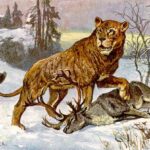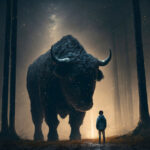Roaming Shadows: The Enigmatic Legacy of the Ice Age Cave Lion
In the dim recesses of the Pleistocene epoch, a fearsome predator prowled the ancient landscapes of Eurasia and North America. Known as the cave lion, this majestic feline ruled the icy tundras and dense forests, leaving an indelible mark on the prehistoric world. As we delve into the shadowy realm of this formidable apex predator, we uncover the mysteries of its existence and contemplate its enduring legacy.
An Ice Age Icon: Master of the Frozen Wilds
The cave lion (Panthera leo spelaea) emerged during the Late Pleistocene period, roughly 370,000 years ago, and persisted until the end of the last Ice Age around 10,000 years ago. Resembling its modern relatives but larger in size, the cave lion stood as one of the largest felids of its time, with males weighing up to 500 kilograms (1,100 pounds). Its thick fur, robust build, and formidable claws made it uniquely suited to the harsh conditions of the glacial landscapes it inhabited.
Hunting Shadows: Strategies of the Cave Lion
As apex predators, cave lions occupied the top of the Pleistocene food chain, preying on a variety of large herbivores such as bison, horses, and deer. They likely employed stealth and ambush tactics to bring down their formidable quarry, relying on their strength, agility, and keen senses to secure a successful kill. Cave lion fossils often exhibit signs of healed injuries, suggesting that they engaged in frequent confrontations with prey and rivals.
Artistic Echoes: Cave Lion in Prehistoric Art
The cave lion’s formidable presence did not escape the notice of early humans, who immortalized its likeness in the ancient caves of Europe and Siberia. Paleolithic artists depicted the cave lion in intricate detail, capturing its powerful physique and piercing gaze with remarkable precision. These cave paintings and sculptures offer a glimpse into the ancient world and the reverence with which our ancestors viewed these majestic predators.
Fading Shadows: The End of an Era
Despite its dominance during the Pleistocene epoch, the cave lion ultimately succumbed to the same forces that shaped its existence. As the Ice Age drew to a close, shifting climates and dwindling prey populations spelled doom for this iconic predator. Competition with early humans, along with environmental pressures, likely hastened its demise, leading to the extinction of the cave lion and countless other megafauna.
Legacy of Shadows: Lessons from the Past
As we reflect on the enigmatic legacy of the cave lion, we are reminded of the fragile interplay between species and their environments. The rise and fall of this apex predator serve as a cautionary tale, underscoring the profound impact that climate change, human activity, and ecological shifts can have on the diversity of life on Earth. By studying the remains of the cave lion and its contemporaries, we gain valuable insights into the complex dynamics of ancient ecosystems and the interconnectedness of all living things. In preserving their memory, we honor the magnificent creatures that once roamed the Earth, casting shadows upon the landscapes of our imagination.




